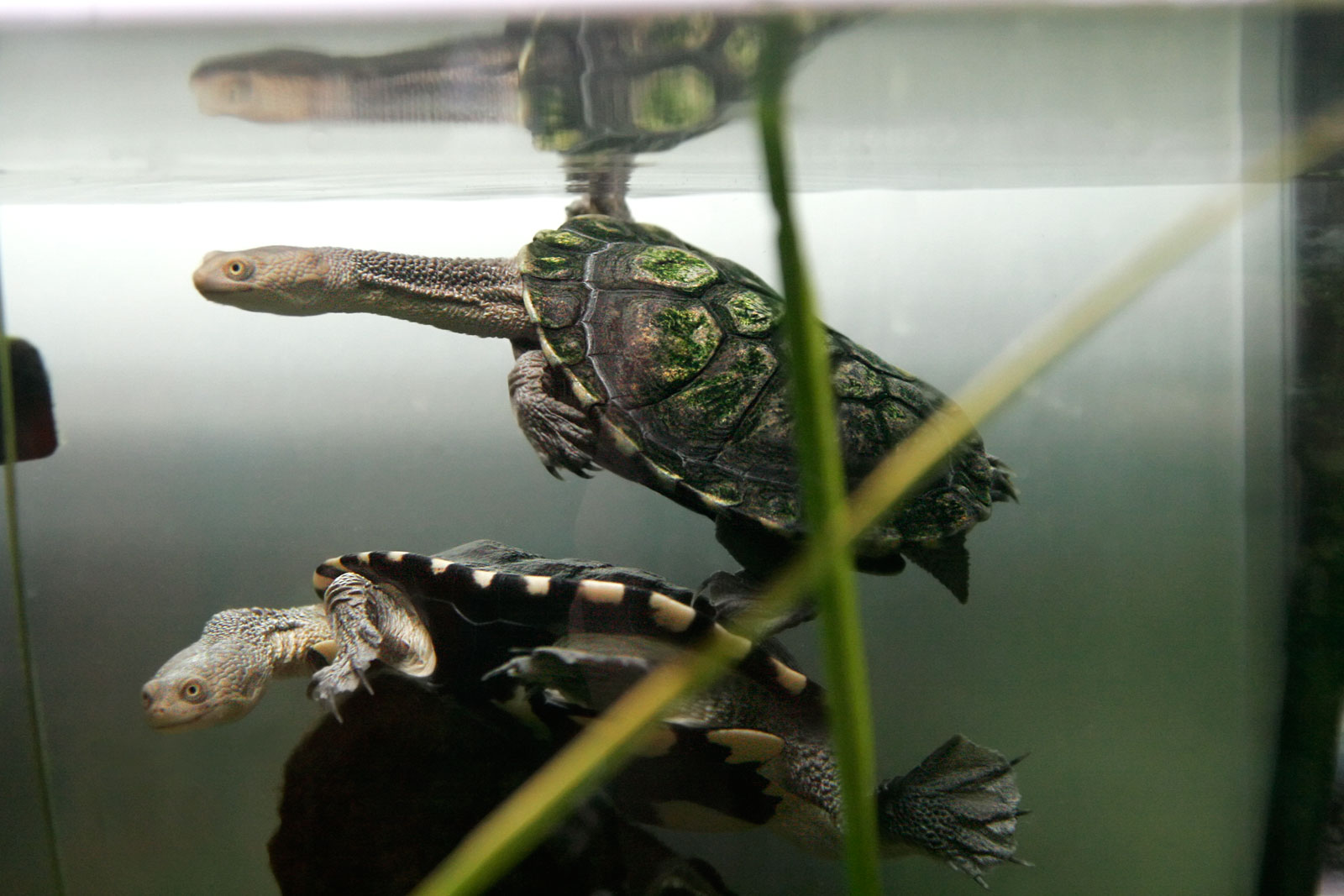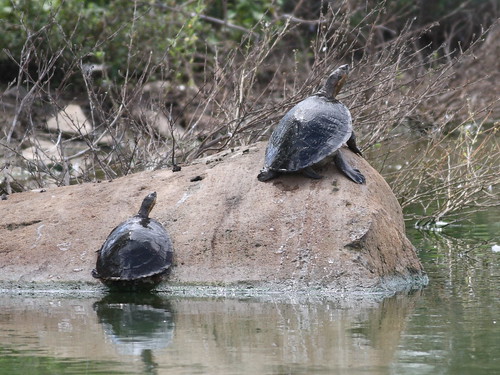(Two eastern long-necked turtles, Chelodina longicollis)
The researchers, collaborators from the University of North Carolina and the University of Canberra, based their conclusions on data collected in 19 water bodies in Gungahlin, a Canberra suburb, and in adjacent nature reserves of the Australian Capital Territory. At each site, they measured a host of environmental variables, including surface area of the water body, maximum depth, dissolved oxygen content and pH, conductivity, coverage by emergent vegetation, and relative abundance of the turtles' prey. The researchers also looked at characteristics of the habitat within a 500-meter radius of each wetland--in other words, the area where turtles might be expected to spend time when they are not in the water. Focal traits included the density of roads, proportions of different types of land cover (grassland, woodland, farm and rangeland, urban infrastructure, urban green space, other water bodies), and distance to the nearest road.
In order to capture and measure the turtles, the scientists used crab traps baited with liver and sardines. They measured the mass, carapace length, and midline plastron length of each individual; classified the turtles as juveniles or adults; and determined the sex of all adults. While collecting these morphometric data, the researchers examined the turtles' shells for any evidence of injury. Then they marked each turtle by filing notches into a unique combination of marginal scutes. This allowed the scientists to identify any recaptures--enabling them to measure growth and, where relevant, movement from one wetland to another, between capture events.
(Canberra, Australian Capital Territory, Australia)
At the level of water bodies, there were very few differences between suburban and natural sites; surface area, maximum depth, coverage of emergent vegetation, prey abundance, and dissolved oxygen were all similar. Further, many of the same species dominated the vegetation in and around the ponds. However, conductivity and pH were higher in suburban water bodies--likely a result of solutes carried into suburban ponds by runoff from impervious surface cover. Luckily for the turtles, whose growth and physiological stability can be affected by these water characteristics, the values were not high enough to have any negative impacts.
Differences between the two types of site were more evident at the broader landscape level. Suburban water bodies were nearer to roads and surrounded by higher road densities, urban infrastructure, and urban green spaces; natural wetlands were surrounded by higher proportions of woodland and grassland habitats.
Perhaps most surprising were the results of the turtle captures. Nearly three times as many turtles were captured in suburban water bodies as in natural sites; in fact, because capture rates were so low in the latter areas, the researchers went out and sampled from 6 additional natural wetlands in order to have a large enough sample size for comparisons of morphometric data. In both types of sites, males and females could be found in equal proportions--a notable result since females in "bad" habitats are often injured or killed when they leave the pond to find a place to lay eggs. The researchers also failed to find any differences in injury incidence between the two sites.
(Long-necked turtle holding up traffic)
Size-frequency distributions differed between the suburban and natural sites. However, in an unexpected twist, this was due to an abundance of smaller adults in nature reserves compared to a larger aggregation of big adults in the suburbs. This was probably driven by the fact that juvenile growth rates were more than 5 times higher in suburban areas. Interestingly, 3.2% of recaptured turtles originally caught at wetland sites were sampled for the second time at suburban wetlands; however, none of the turtles originally caught at suburban sites were later caught in natural areas.
Thus, despite the fact that the suburban habitats contained many features traditionally associated with negative impacts on turtle populations--high road densities, extensive anthropogenic structures, high-conductivity water--the suburban turtle populations appeared to be neutrally, or even positively, responsive to suburban development. In large part, this may be facilitated by the fact that the suburban turtles in Canberra can use vegetated drainage lines and under-road culverts to move around anthropogenic environments without suffering mortality or injury from vehicular collisions.
(Eastern long-necked turtles sunning on a rock on the University of Queensland campus)
Although the researchers documented similar numbers of potential nesting sites in the landscape around the wetland areas, they were not able to examine differences in nest site quality; this may have driven some of the variation observed between the two types of site. The results also appear to have been influenced by the extended drought that occurred throughout the study period. In the suburbs, water bodies did not dry up as quickly, allowing turtles to remain "aquatically active" rather than retreating to land and going dormant, as many of their "natural" counterparts did. This likely affected the sizes and growth rates of turtles at the natural wetland sites. This effect highlights the potential importance of anthropogenic water features in hot and/or arid climates--for both resident animals and those that migrate from neighboring habitats, they can be an influential source of food and shelter.
Based on the positive impacts of suburban wetlands on the eastern long-necked turtle, the authors suggest that urban water bodies should be developed as refuges for wildlife. After all, these sites can often be more stable and resource-rich than nearby natural areas. However, care should be taken to position them in safe places throughout the landscape--where possible, they should be located away from roads or near safe crossing structures such as under-road culverts. In the current study, 46 turtles (or about 7% of the total number sampled) were found on just one road between reserve and suburban water bodies. Perhaps future studies can investigate the factors associated with turtle movement between these different habitats in order to develop plans for minimizing any potential human-turtle conflict.
---
Roe, J.H., Rees, M., Georges, A. 2011. Suburbs: dangers or drought refugia for freshwater turtle populations? The Journal of Wildlife Management 75(7):1544-1552.
Thanks to the following websites for providing the images used in this post:
http://en.wikipedia.org/wiki/File:Eastern_long_neck_tortoise_-_chelodina_longicollis03.jpg
http://www.flickr.com/photos/arthur_chapman/3028063857/
http://www.kangacup.com/about-us/about-canberra/
http://www.australian-4x4.com.au/fraser-island-australia.html




No comments:
Post a Comment